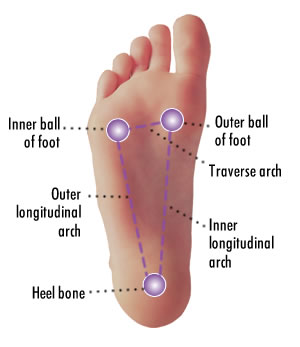All About the Arches
Arches absorb most of the pressure and force from the ground when we stand or walk. Each foot has a total of three arches.
- The Medial Longitudinal Arch is the one most people refer to as “the arch” and it runs lengthwise on the inside of your foot. The main task for this arch is to absorb shock from walking, running, jumping, etc.
- The Lateral Longitudinal Arch is parallel to the Medial arch; it runs along the outside of the foot.
- The third arch is the Transverse Arch; this one runs across the middle of the foot from the outside to the inside. The main purpose of this arch is to give flexibility and support for the foot.
 There are many muscles and tendons in the foot that provide vital support for the arches. The arches of our feet vary naturally from person to person, and foot arches also change due to age and medical conditions, so the best way to find good arch support is to find out what your own specific arch needs are. You can check out your arches by looking in a mirror, or you can dip your foot in water and make a footprint. Those with flat feet or low arches won’t see much of a curve, and those with high arches will see that the middle of the footprint is skinnier than the heel and ball of the foot. Pregnant women will often find that their arches flatten due to the extra weight and pressure on their feet. Rheumatoid arthritis and age may also contribute to flattened arches. Purchasing shoes with arch support or adding insoles that provide arch support can help to relieve some of the extra pressure and stress that low arches place on the feet. Pronation is a pattern of movement that the feet do and varies based on high or low arches. People with lower arches tend to over-pronate, which causes the foot to turn too far inwards when walking. Those with higher arches may turn the foot too far outward, known as under-pronation. The feet’s pattern of movement affects the posture and movement of the rest of your body, particularly your legs and hips. Wearing appropriate shoes can help to improve your overall posture and wellbeing. People with low arches should look for shoes that help with “motion control”—these shoes have extra support to keep the foot from rolling inwards and causing misalignment in the rest of your body. People with high arches should look for “cushioning” shoes that encourage feet to roll more inward. The best thing about arch support is that you can feel the results almost immediately because it takes the pressure off your legs and reduces the overall pressure on your feet.
There are many muscles and tendons in the foot that provide vital support for the arches. The arches of our feet vary naturally from person to person, and foot arches also change due to age and medical conditions, so the best way to find good arch support is to find out what your own specific arch needs are. You can check out your arches by looking in a mirror, or you can dip your foot in water and make a footprint. Those with flat feet or low arches won’t see much of a curve, and those with high arches will see that the middle of the footprint is skinnier than the heel and ball of the foot. Pregnant women will often find that their arches flatten due to the extra weight and pressure on their feet. Rheumatoid arthritis and age may also contribute to flattened arches. Purchasing shoes with arch support or adding insoles that provide arch support can help to relieve some of the extra pressure and stress that low arches place on the feet. Pronation is a pattern of movement that the feet do and varies based on high or low arches. People with lower arches tend to over-pronate, which causes the foot to turn too far inwards when walking. Those with higher arches may turn the foot too far outward, known as under-pronation. The feet’s pattern of movement affects the posture and movement of the rest of your body, particularly your legs and hips. Wearing appropriate shoes can help to improve your overall posture and wellbeing. People with low arches should look for shoes that help with “motion control”—these shoes have extra support to keep the foot from rolling inwards and causing misalignment in the rest of your body. People with high arches should look for “cushioning” shoes that encourage feet to roll more inward. The best thing about arch support is that you can feel the results almost immediately because it takes the pressure off your legs and reduces the overall pressure on your feet.

